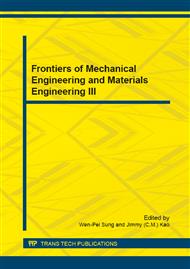p.327
p.331
p.335
p.339
p.345
p.349
p.354
p.358
p.362
Time Interval and Chilling Effects on it during the Forming Process Surfacing Deposition Forming
Abstract:
In this paper, time interval between neighbored layers during the forming process of Surfacing Deposition Forming is defined. Then, surfacing deposition forming are experimented on Cu chilling pedestal and cast iron pedestal individually, the experimental data are processed with Matlab software to research the relationship between time interval and forming layer number, and t method of inspection is exploited to verify the validity of this relationship, even chilling effects on this relationship is studied at the same time. The result shows that: Time interval between neighbored layers would rise more and longer along with the progress of the forming process, and it has a linear relationship with layer number in generally; As the chilling effect, time interval is shortened prodigious, and its relationship with layer number changed to be a cubic curve function.
Info:
Periodical:
Pages:
345-348
Citation:
Online since:
January 2015
Authors:
Keywords:
Price:
Сopyright:
© 2015 Trans Tech Publications Ltd. All Rights Reserved
Share:
Citation:


